Antennal Transcriptome of the Fruit-Sucking Moth Eudocima materna: Identification of Olfactory Genes and Preliminary Evidence for RNA-Editing Events in Odorant Receptors
Abstract
1. Introduction
2. Materials and Methods
2.1. Insects
2.2. RNA Isolation
2.3. CDNA Library Construction and RNA Sequencing
2.4. Illumina Sequencing
2.5. De Novo Transcriptome Assembly and Functional Annotation
2.6. Gene Ontology and KEGG Pathway Enrichment Analysis for Antennal Transcriptomics
2.7. Data Collection of Olfactory and Chemosensation-Related Sequences of Other Lepidopteran Species
2.8. Olfactory Gene Identification and Phylogenetic Analyses of Antennal Transcriptome
2.9. Identification of Transposable Element-Related Transcripts
2.10. CDNA Synthesis for Sequence Validation
2.11. STRING Protein Interacting Network Analysis
2.12. RNA-Editing Site Prediction
3. Results
3.1. Sequencing and Unigene Assembly
3.2. Functional Annotation
3.3. RT-PCR Validation of Transcripts
3.4. Identification of Olfactory Genes
3.5. Odorant-Binding Proteins
3.6. Odorant Receptors
3.7. Chemosensory Proteins
3.8. Sensory Neuron Membrane Proteins
3.9. Ionotropic Receptors
3.10. Most-Represented Transcripts
3.11. Transposable Elements
3.12. General Transcripts (Non-Olfactory)
3.13. RNA-Editing Events in the FSM Odorant Receptors
4. Discussion
5. Conclusions
Supplementary Materials
Author Contributions
Funding
Institutional Review Board Statement
Informed Consent Statement
Data Availability Statement
Acknowledgments
Conflicts of Interest
References
- Mote, U.; Tambe, A.; Patil, C. Observations on Incidence and Extent of Damage of Fruit Sucking Moths on Pomegranate Fruits. J. Maharashtra Agric. Univ. 1991, 16, 438–439. [Google Scholar]
- Fay, H.C. Evolutionary and Taxonomic Relationships between Fruit-Piercing Moths and the Menispermaceae. Aust. Syst. Bot. 1996, 9, 227–233. [Google Scholar] [CrossRef]
- Denton, G.; Muniappan, R.; Marutani, M.; McConnell, J.; Lali, T. Biology and Natural Enemies of the Fruit-Piercing Moth Othreis Fullonia (Lepidoptera: Noctuidae) from Guam; Research Extension Series-College of Tropical Agriculture and Human Resources; University of Hawaii, Cooperative Extension Service (USA): Honolulu, HI, USA, 1991. [Google Scholar]
- Bhumannavar, B.S. Studies on Fruit Piercing Moths (Lepidoptera: Noctuidae)-Species Composition, Biology and Natural Enemies. Ph.D. Thesis, University of Agricultural Sciences, Bengaluru, India, 2000. [Google Scholar]
- Sands, D.; Liebregts, W.; Broe, R. Biological Control of the Fruit Piercing Moth, Othreis Fullonia (Clerck) (Lepidoptera: Noctuidae) in the Pacific. Micronesica 1993, 4, 25–31. [Google Scholar]
- Bhumannavar, B.; Viraktamath, C. Biology, Ecology and Management of Fruit Piercing Moths (Lepidoptera: Noctuidae). Pest Manag. Hortic. Ecosyst. 2012, 18, 1–18. [Google Scholar]
- Pandey, A.; Pandey, A.; Singh, M. Antifeeding, Repellent and Insecticidal Efficacy of Plant Products Against Helicoverpa Armigera. Ann. Plant Prot. Sci. 2010, 18, 304–306. [Google Scholar]
- Field, L.; Pickett, J.; Wadhams, L. Molecular Studies in Insect Olfaction. Insect Mol. Biol. 2000, 9, 545–551. [Google Scholar] [CrossRef]
- Pitts, R.J.; Rinker, D.C.; Jones, P.L.; Rokas, A.; Zwiebel, L.J. Transcriptome Profiling of Chemosensory Appendages in the Malaria Vector Anopheles Gambiae Reveals Tissue-and Sex-Specific Signatures of Odor Coding. BMC Genom. 2011, 12, 271. [Google Scholar] [CrossRef]
- Schneider, D. Insect Antennae. Annu. Rev. Entomol. 1964, 9, 103–122. [Google Scholar] [CrossRef]
- Steinbrecht, R.A. Pore Structures in Insect Olfactory Sensilla: A Review of Data and Concepts. Int. J. Insect Morphol. Embryol. 1997, 26, 229–245. [Google Scholar]
- Pelosi, P.; Zhou, J.; Ban, L.; Calvello, M. Soluble Proteins in Insect Chemical Communication. Cell. Mol. Life Sci. CMLS 2006, 63, 1658–1676. [Google Scholar] [CrossRef]
- Pelosi, P.; Iovinella, I.; Felicioli, A.; Dani, F.R. Soluble Proteins of Chemical Communication: An Overview Across Arthropods. Front. Physiol. 2014, 5, 320. [Google Scholar] [CrossRef] [PubMed]
- Pelosi, P.; Iovinella, I.; Zhu, J.; Wang, G.; Dani, F.R. Beyond Chemoreception: Diverse Tasks of Soluble Olfactory Proteins in Insects. Biol. Rev. 2018, 93, 184–200. [Google Scholar] [CrossRef] [PubMed]
- Clyne, P.J.; Warr, C.G.; Freeman, M.R.; Lessing, D.; Kim, J.; Carlson, J.R. A Novel Family of Divergent Seven-Transmembrane Proteins: Candidate Odorant Receptors in Drosophila. Neuron 1999, 22, 327–338. [Google Scholar] [CrossRef]
- Leal, W.S. Odorant Reception in Insects: Roles of Receptors, Binding Proteins, and Degrading Enzymes. Annu. Rev. Entomol. 2013, 58, 373–391. [Google Scholar] [CrossRef] [PubMed]
- Wicher, D. Olfactory signaling in insects. In Progress in Molecular Biology and Translational Science; Anonymous; Elsevier: Amsterdam, The Netherlands, 2015; Volume 130, pp. 37–54. [Google Scholar]
- Vogt, R.G.; Riddiford, L.M. Pheromone Binding and Inactivation by Moth Antennae. Nature 1981, 293, 161. [Google Scholar] [CrossRef] [PubMed]
- Vogt, R.G.; Prestwich, G.D.; Lerner, M.R. Odorant-binding-protein Subfamilies Associate with Distinct Classes of Olfactory Receptor Neurons in Insects. J. Neurobiol. 1991, 22, 74–84. [Google Scholar] [CrossRef]
- Depan Cao, Y.L.; Wei, J.; Liao, X.; Walker, W.B.; Li, J.; Wang, G. Identification of Candidate Olfactory Genes in Chilo Suppressalis by Antennal Transcriptome Analysis. Int. J. Biol. Sci. 2014, 10, 846. [Google Scholar]
- Jia, X.; Wang, H.; Yan, Z.; Zhang, M.; Wei, C.; Qin, X.; Ji, W.; Falabella, P.; Du, Y. Antennal Transcriptome and Differential Expression of Olfactory Genes in the Yellow Peach Moth, Conogethes Punctiferalis (Lepidoptera: Crambidae). Sci. Rep. 2016, 6, 29067. [Google Scholar] [CrossRef]
- Jia, X.; Zhang, X.; Liu, H.; Wang, R.; Zhang, T. Identification of Chemosensory Genes from the Antennal Transcriptome of Indian Meal Moth Plodia Interpunctella. PLoS ONE 2018, 13, e0189889. [Google Scholar] [CrossRef]
- Du, L.; Liu, Y.; Zhang, J.; Gao, X.; Wang, B.; Wang, G. Identification and Characterization of Chemosensory Genes in the Antennal Transcriptome of Spodoptera Exigua. Comp. Biochem. Physiol. Part D Genom. Proteom. 2018, 27, 54–65. [Google Scholar]
- Liu, N.; Zhang, T.; Ye, Z.; Li, F.; Dong, S. Identification and Characterization of Candidate Chemosensory Gene Families from Spodoptera Exigua Developmental Transcriptomes. Int. J. Biol. Sci. 2015, 11, 1036. [Google Scholar] [CrossRef] [PubMed]
- Zeng, F.; Zhao, Z.; Yan, M.; Zhou, W.; Zhang, Z.; Zhang, A.; Lu, Z.; Wang, M. Identification and Comparative Expression Profiles of Chemoreception Genes Revealed from Major Chemoreception Organs of the Rice Leaf Folder, Cnaphalocrocis Medinalis (Lepidoptera: Pyralidae). PLoS ONE 2015, 10, e0144267. [Google Scholar] [CrossRef] [PubMed]
- Liu, S.; Wang, W.; Zhang, Y.; Zhang, B.; Rao, X.; Liu, X.; Wang, D.; Li, S. Transcriptome Sequencing Reveals Abundant Olfactory Genes in the Antennae of the Rice Leaffolder, Cnaphalocrocis Medinalis (Lepidoptera: Pyralidae). Entomol. Sci. 2017, 20, 177–188. [Google Scholar] [CrossRef]
- Yang, S.; Cao, D.; Wang, G.; Liu, Y. Identification of Genes Involved in Chemoreception in Plutella xyllostella by Antennal Transcriptome Analysis. Sci. Rep. 2017, 7, 11941. [Google Scholar] [CrossRef]
- Feng, B.; Guo, Q.; Zheng, K.; Qin, Y.; Du, Y. Antennal Transcriptome Analysis of the Piercing Moth Oraesia Emarginata (Lepidoptera: Noctuidae). PLoS ONE 2017, 12, e0179433. [Google Scholar] [CrossRef][Green Version]
- Vieira, F.G.; Sánchez-Gracia, A.; Rozas, J. Comparative Genomic Analysis of the Odorant-Binding Protein Family in 12 Drosophila Genomes: Purifying Selection and Birth-and-Death Evolution. Genome Biol. 2007, 8, R235. [Google Scholar] [CrossRef]
- Tonkin, L.A.; Saccomanno, L.; Morse, D.P.; Brodigan, T.; Krause, M.; Bass, B.L. RNA Editing by ADARs is Important for Normal Behavior in Caenorhabditis Elegans. EMBO J. 2002, 21, 6025–6035. [Google Scholar] [CrossRef]
- Hoopengardner, B.; Bhalla, T.; Staber, C.; Reenan, R. Nervous System Targets of RNA Editing Identified by Comparative Genomics. Science 2003, 301, 832–836. [Google Scholar] [CrossRef]
- Palladino, M.J.; Keegan, L.P.; O’connell, M.A.; Reenan, R.A. A-to-I Pre-mRNA Editing in Drosophila is Primarily Involved in Adult Nervous System Function and Integrity. Cell 2000, 102, 437–449. [Google Scholar] [CrossRef]
- Bass, B.L. RNA Editing by Adenosine Deaminases that Act on RNA. Annu. Rev. Biochem. 2002, 71, 817–846. [Google Scholar] [CrossRef]
- Maas, S.; Rich, A.; Nishikura, K. A-to-I RNA Editing: Recent News and Residual Mysteries. J. Biol. Chem. 2003, 278, 1391–1394. [Google Scholar] [CrossRef] [PubMed]
- Porath, H.T.; Hazan, E.; Shpigler, H.; Cohen, M.; Band, M.; Ben-Shahar, Y.; Levanon, E.Y.; Eisenberg, E.; Bloch, G. RNA Editing is Abundant and Correlates with Task Performance in a Social Bumblebee. Nat. Commun. 2019, 10, 1605. [Google Scholar] [CrossRef] [PubMed]
- Ewels, P.; Magnusson, M.; Lundin, S.; Käller, M. MultiQC: Summarize Analysis Results for Multiple Tools and Samples in a Single Report. Bioinformatics 2016, 32, 3047–3048. [Google Scholar] [CrossRef] [PubMed]
- Bolger, A.M.; Lohse, M.; Usadel, B. Trimmomatic: A Flexible Trimmer for Illumina Sequence Data. Bioinformatics 2014, 30, 2114–2120. [Google Scholar] [CrossRef] [PubMed]
- Grabherr, M.G.; Haas, B.J.; Yassour, M.; Levin, J.Z.; Thompson, D.A.; Amit, I.; Adiconis, X.; Fan, L.; Raychowdhury, R.; Zeng, Q. Full-Length Transcriptome Assembly from RNA-Seq Data without a Reference Genome. Nat. Biotechnol. 2011, 29, 644. [Google Scholar] [CrossRef]
- Fu, L.; Niu, B.; Zhu, Z.; Wu, S.; Li, W. CD-HIT: Accelerated for Clustering the Next-Generation Sequencing Data. Bioinformatics 2012, 28, 3150–3152. [Google Scholar] [CrossRef]
- Moriya, Y.; Itoh, M.; Okuda, S.; Yoshizawa, A.C.; Kanehisa, M. KAAS: An Automatic Genome Annotation and Pathway Reconstruction Server. Nucleic Acids Res. 2007, 35, W182–W185. [Google Scholar] [CrossRef]
- Apweiler, R.; Bairoch, A.; Wu, C.H.; Barker, W.C.; Boeckmann, B.; Ferro, S.; Gasteiger, E.; Huang, H.; Lopez, R.; Magrane, M. UniProt: The Universal Protein Knowledgebase. Nucleic Acids Res. 2004, 32, D115–D119. [Google Scholar] [CrossRef]
- Maere, S.; Heymans, K.; Kuiper, M. BiNGO: A Cytoscape Plugin to Assess Overrepresentation of Gene Ontology Categories in Biological Networks. Bioinformatics 2005, 21, 3448–3449. [Google Scholar] [CrossRef]
- Ye, J.; Fang, L.; Zheng, H.; Zhang, Y.; Chen, J.; Zhang, Z.; Wang, J.; Li, S.; Li, R.; Bolund, L. WEGO: A Web Tool for Plotting GO Annotations. Nucleic Acids Res. 2006, 34, W293–W297. [Google Scholar] [CrossRef]
- Edgar, R.C. MUSCLE: Multiple Sequence Alignment with High Accuracy and High Throughput. Nucleic Acids Res. 2004, 32, 1792–1797. [Google Scholar] [CrossRef] [PubMed]
- Kumar, S.; Stecher, G.; Li, M.; Knyaz, C.; Tamura, K. MEGA X: Molecular Evolutionary Genetics Analysis Across Computing Platforms. Mol. Biol. Evol. 2018, 35, 1547–1549. [Google Scholar] [CrossRef] [PubMed]
- Von Mering, C.; Jensen, L.J.; Snel, B.; Hooper, S.D.; Krupp, M.; Foglierini, M.; Jouffre, N.; Huynen, M.A.; Bork, P. STRING: Known and Predicted Protein–protein Associations, Integrated and Transferred Across Organisms. Nucleic Acids Res. 2005, 33, D433–D437. [Google Scholar] [CrossRef] [PubMed]
- Nigita, G.; Alaimo, S.; Ferro, A.; Giugno, R.; Pulvirenti, A. Knowledge in the Investigation of A-to-I RNA Editing Signals. Front. Bioeng. Biotechnol. 2015, 3, 18. [Google Scholar] [CrossRef][Green Version]
- Eggington, J.M.; Greene, T.; Bass, B.L. Predicting Sites of ADAR Editing in Double-Stranded RNA. Nat. Commun. 2011, 2, 319. [Google Scholar] [CrossRef]
- Curtin, K.D.; Meinertzhagen, I.A.; Wyman, R.J. Basigin (EMMPRIN/CD147) Interacts with Integrin to Affect Cellular Architecture. J. Cell. Sci. 2005, 118, 2649–2660. [Google Scholar] [CrossRef]
- Najyb, O.; Brissette, L.; Rassart, E. Apolipoprotein D Internalization is a Basigin-Dependent Mechanism. J. Biol. Chem. 2015, 290, 16077–16087. [Google Scholar] [CrossRef]
- Sørbø, J.G.; Moe, S.E.; Holen, T. Early Upregulation in Nasal Epithelium and Strong Expression in Olfactory Bulb Glomeruli Suggest a Role for Aquaporin-4 in Olfaction. FEBS Lett. 2007, 581, 4884–4890. [Google Scholar]
- Gilbert, C.; Peccoud, J.; Cordaux, R. Transposable Elements and the Evolution of Insects. Annu. Rev. Entomol. 2021, 66, 355–372. [Google Scholar] [CrossRef]
- Martins, S.; Naish, N.; Walker, A.; Morrison, N.; Scaife, S.; Fu, G.; Dafa’Alla, T.; Alphey, L. Germline Transformation of the Diamondback Moth, Plutella xylostella L., using the piggyBac Transposable Element. Insect Mol. Biol. 2012, 21, 414–421. [Google Scholar] [CrossRef]
- Talla, V.; Suh, A.; Kalsoom, F.; Dincă, V.; Vila, R.; Friberg, M.; Wiklund, C.; Backström, N. Rapid Increase in Genome Size as a Consequence of Transposable Element Hyperactivity in Wood-White (Leptidea) Butterflies. Genome Biol. Evol. 2017, 9, 2491–2505. [Google Scholar] [CrossRef] [PubMed]
- Peccoud, J.; Loiseau, V.; Cordaux, R.; Gilbert, C. Massive Horizontal Transfer of Transposable Elements in Insects. Proc. Natl. Acad. Sci. USA 2017, 114, 4721–4726. [Google Scholar] [CrossRef] [PubMed]
- Schrader, L.; Kim, J.W.; Ence, D.; Zimin, A.; Klein, A.; Wyschetzki, K.; Weichselgartner, T.; Kemena, C.; Stökl, J.; Schultner, E. Transposable Element Islands Facilitate Adaptation to Novel Environments in an Invasive Species. Nat. Commun. 2014, 5, 5495. [Google Scholar] [CrossRef] [PubMed]
- Xiao, W.; Yang, L.; Xu, Z.; He, L. Transcriptomics and Identification of Candidate Chemosensory Genes in Antennae of Conogethes Punctiferalis (Lepidoptera: Crambidae). J. Asia-Pac. Entomol. 2016, 19, 911–920. [Google Scholar] [CrossRef]
- Zhang, S.; Zhang, Z.; Wang, H.; Kong, X. Antennal Transcriptome Analysis and Comparison of Olfactory Genes in Two Sympatric Defoliators, Dendrolimus Houi and Dendrolimus Kikuchii (Lepidoptera: Lasiocampidae). Insect Biochem. Mol. Biol. 2014, 52, 69–81. [Google Scholar] [CrossRef]
- Liu, Y.; Gu, S.; Zhang, Y.; Guo, Y.; Wang, G. Candidate Olfaction Genes Identified within the Helicoverpa Armigera Antennal Transcriptome. PLoS ONE 2012, 7, e48260. [Google Scholar] [CrossRef]
- Zhang, Y.; Jin, J.; Jin, R.; Xia, Y.; Zhou, J.; Deng, J.; Dong, S. Differential Expression Patterns in Chemosensory and Non-Chemosensory Tissues of Putative Chemosensory Genes Identified by Transcriptome Analysis of Insect Pest the Purple Stem Borer Sesamia Inferens (Walker). PLoS ONE 2013, 8, e69715. [Google Scholar]
- Gong, D.; Zhang, H.; Zhao, P.; Xia, Q.; Xiang, Z. The Odorant Binding Protein Gene Family from the Genome of Silkworm, Bombyx Mori. BMC Genom. 2009, 10, 332. [Google Scholar] [CrossRef]
- Zhang, Y.; Qian, J.; Xu, J.; Zhu, X.; Li, M.; Xu, X.; Liu, C.; Xue, T.; Sun, L. Identification of Chemosensory Genes Based on the Transcriptomic Analysis of Six Different Chemosensory Organs in Spodoptera Exigua. Front. Physiol. 2018, 9, 432. [Google Scholar] [CrossRef]
- Zhang, T.; He, K.; Wang, Z. Transcriptome Comparison Analysis of Ostrinia Furnacalis in Four Developmental Stages. Sci. Rep. 2016, 6, 35008. [Google Scholar] [CrossRef]
- Hu, P.; Tao, J.; Cui, M.; Gao, C.; Lu, P.; Luo, Y. Antennal Transcriptome Analysis and Expression Profiles of Odorant Binding Proteins in Eogystia Hippophaecolus (Lepidoptera: Cossidae). BMC Genom. 2016, 17, 651. [Google Scholar] [CrossRef] [PubMed]
- Li, G.; Du, J.; Li, Y.; Wu, J. Identification of Putative Olfactory Genes from the Oriental Fruit Moth Grapholita Molesta Via an Antennal Transcriptome Analysis. PLoS ONE 2015, 10, e0142193. [Google Scholar] [CrossRef] [PubMed][Green Version]
- Zhu, J.; Ze, S.; Yang, B. Identification and Expression Profiling of Six Chemosensory Protein Genes in the Beet Armyworm, Spodoptera Exigua. J. Asia-Pac. Entomol. 2015, 18, 61–66. [Google Scholar] [CrossRef]
- Xuan, N.; Bu, X.; Liu, Y.Y.; Yang, X.; Liu, G.X.; Fan, Z.X.; Bi, Y.P.; Yang, L.Q.; Lou, Q.N.; Rajashekar, B. Molecular Evidence of RNA Editing in Bombyx Chemosensory Protein Family. PLoS ONE 2014, 9, e86932. [Google Scholar] [CrossRef]
- Grauso, M.; Reenan, R.; Culetto, E.; Sattelle, D. Novel Putative Nicotinic Acetylcholine Receptor Subunit Genes, D Α 5, D Α 6 and D Α 7, in Drosophila Melanogaster Identify a New and Highly Conserved Target of Adenosine Deaminase Acting on RNA-Mediated A-to-I Pre-mRNA Editing. Genetics 2002, 160, 1519–1533. [Google Scholar] [CrossRef]
- Jin, Y.; Tian, N.; Cao, J.; Liang, J.; Yang, Z.; Lv, J. RNA Editing and Alternative Splicing of the Insect nAChR Subunit Alpha6 Transcript: Evolutionary Conservation, Divergence and Regulation. BMC Evol. Biol. 2007, 7, 98. [Google Scholar] [CrossRef]
- Duan, Y.; Dou, S.; Porath, H.T.; Huang, J.; Eisenberg, E.; Lu, J. A-to-I RNA Editing in Honeybees shows Signals of Adaptation and Convergent Evolution. iScience 2021, 24, 101983. [Google Scholar] [CrossRef]
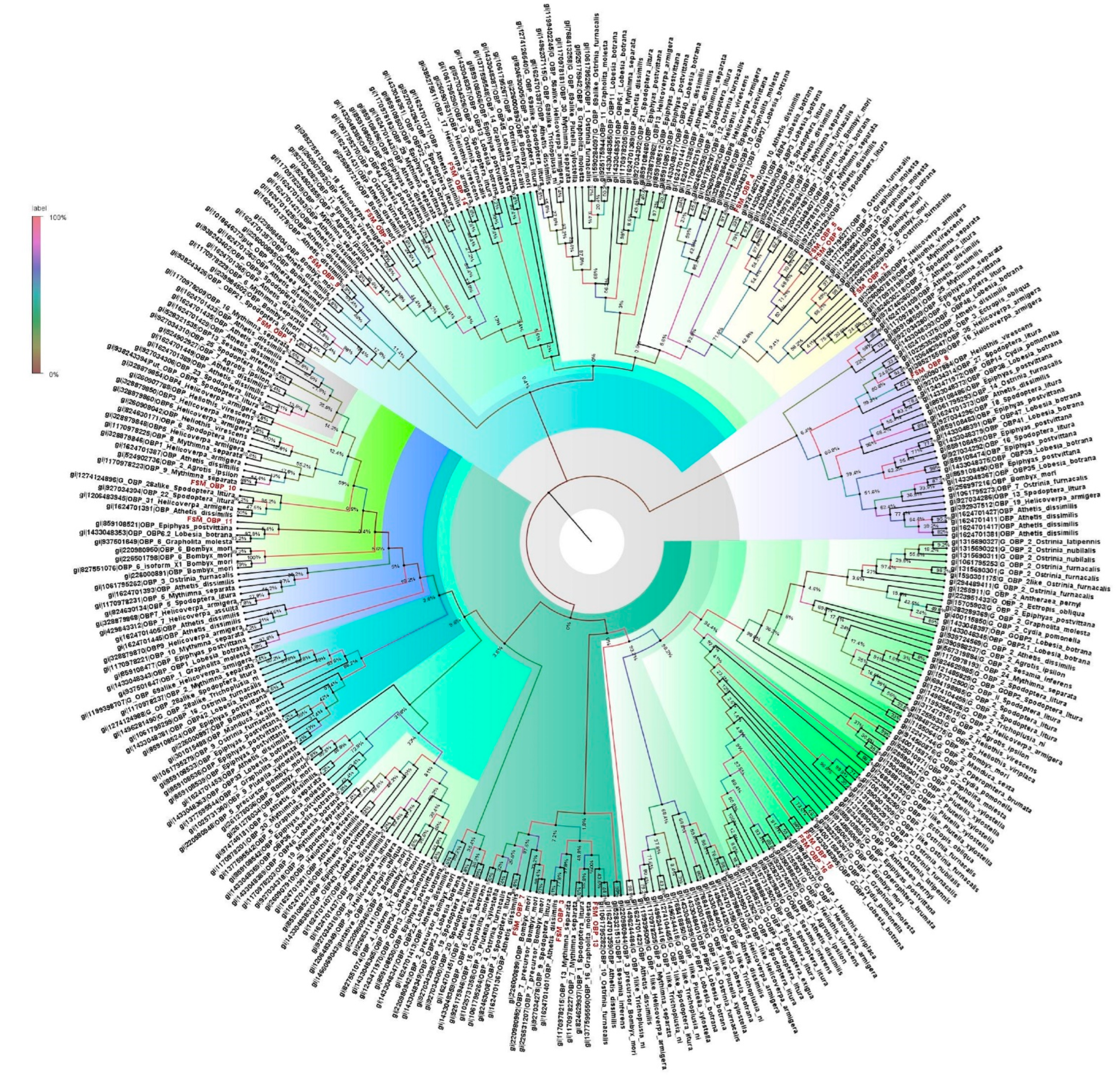
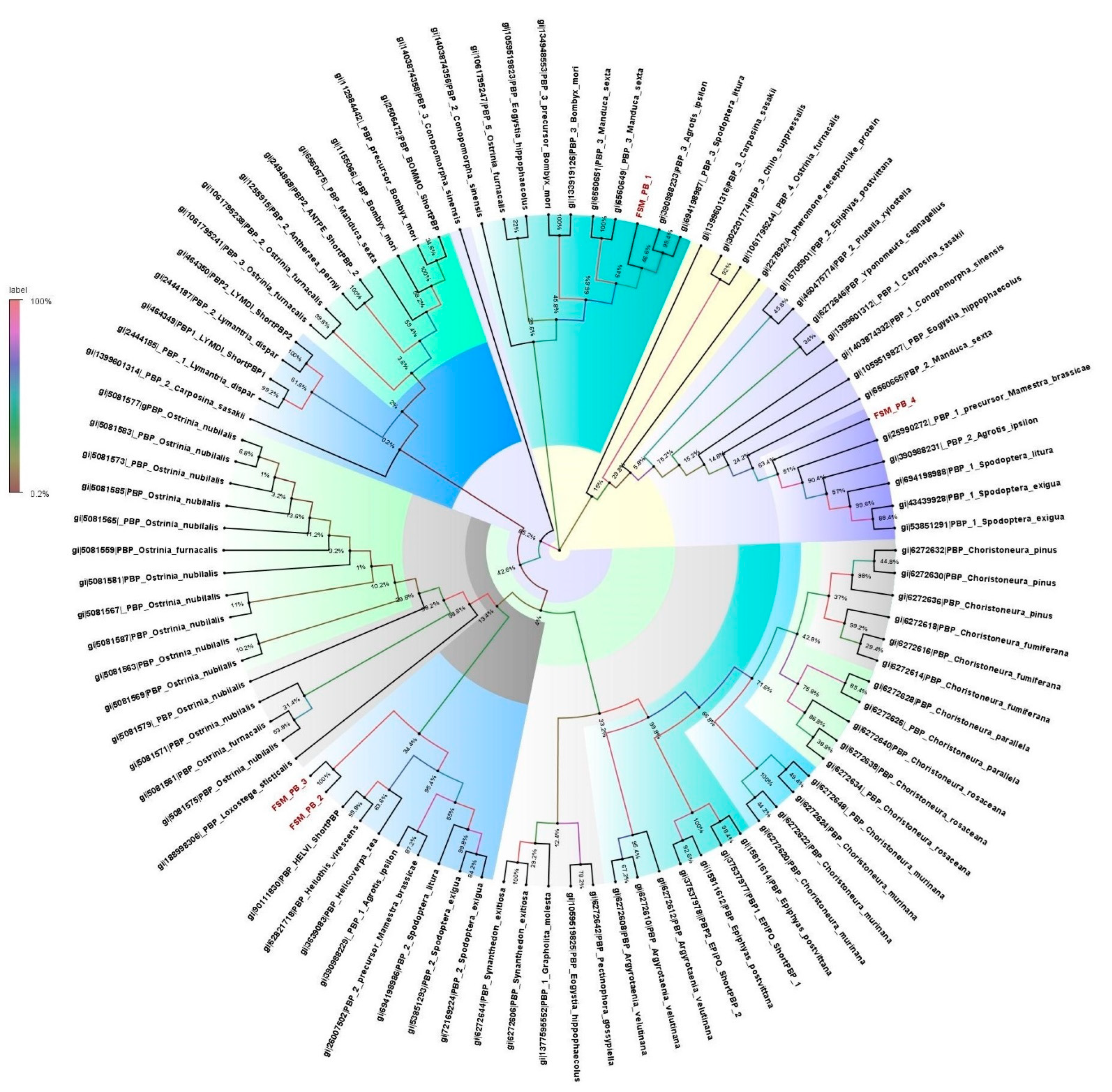
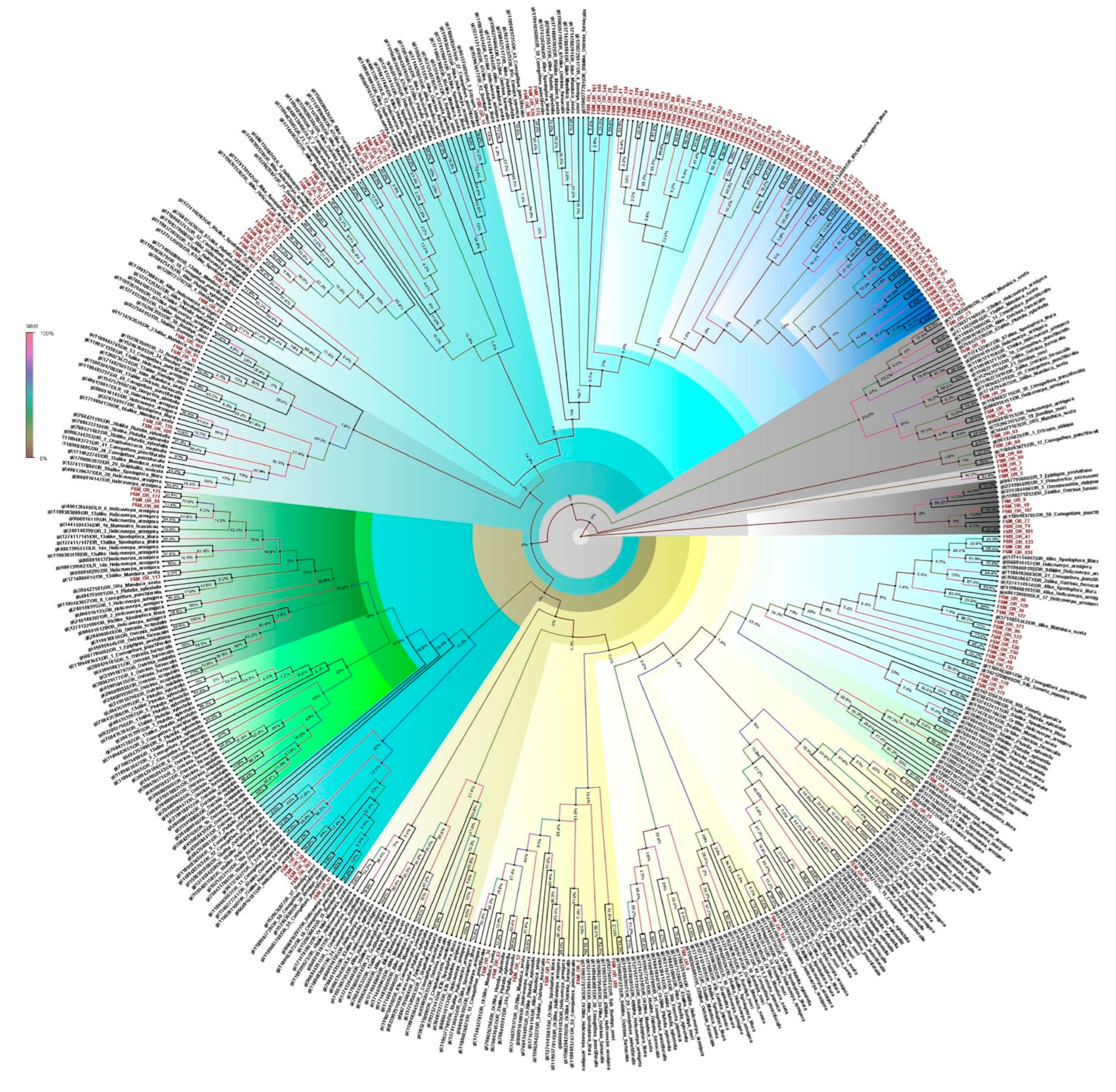

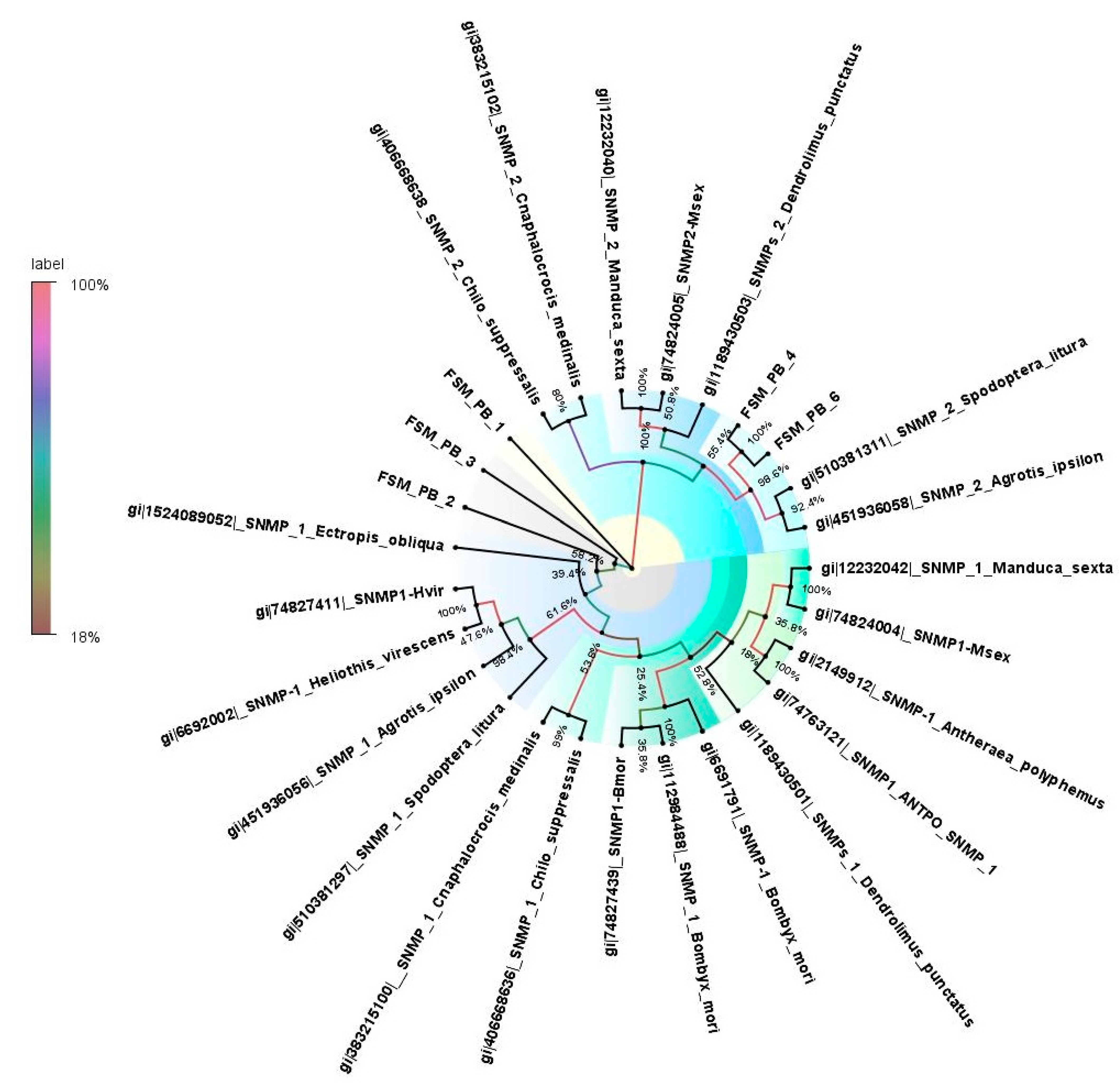
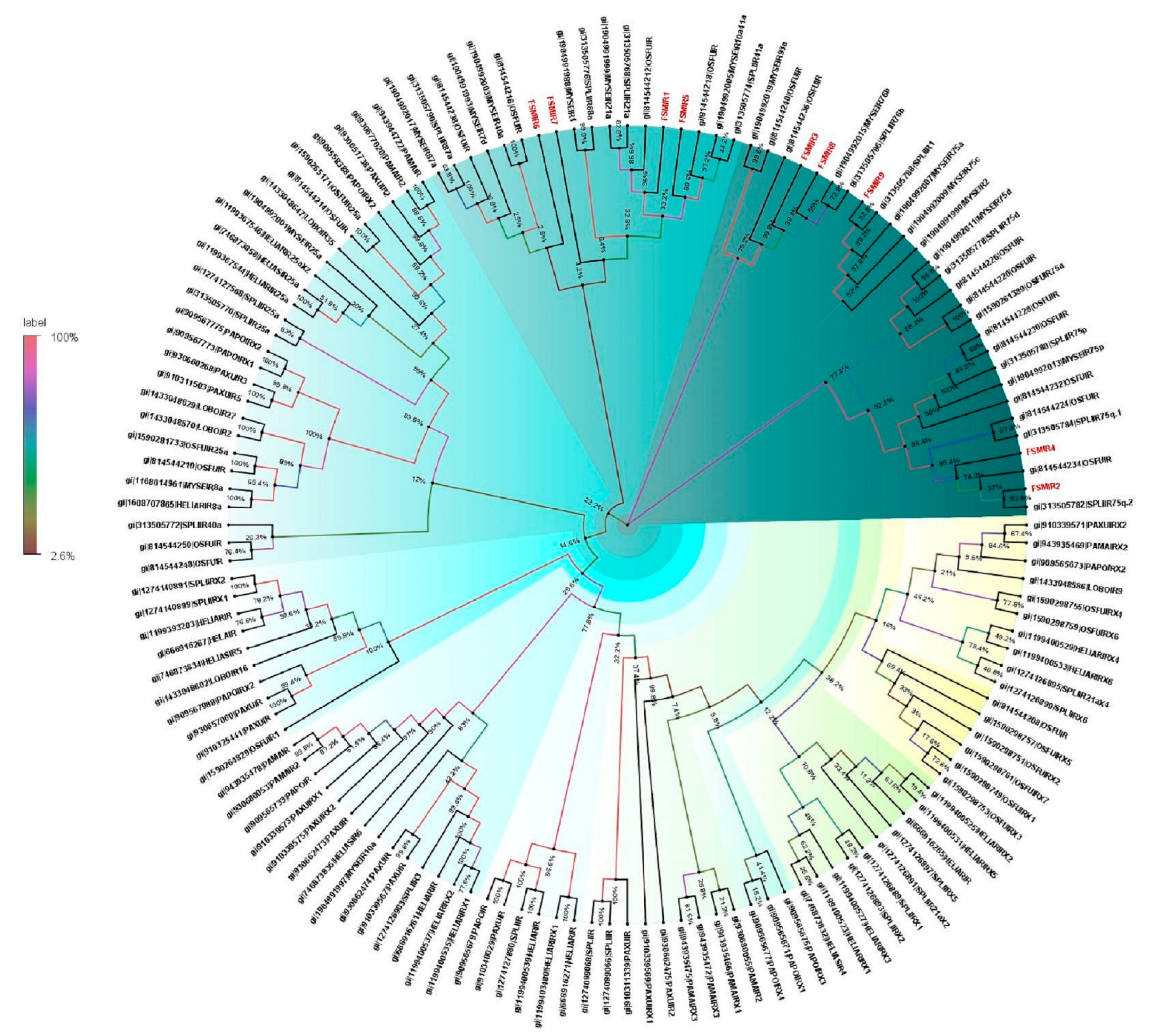
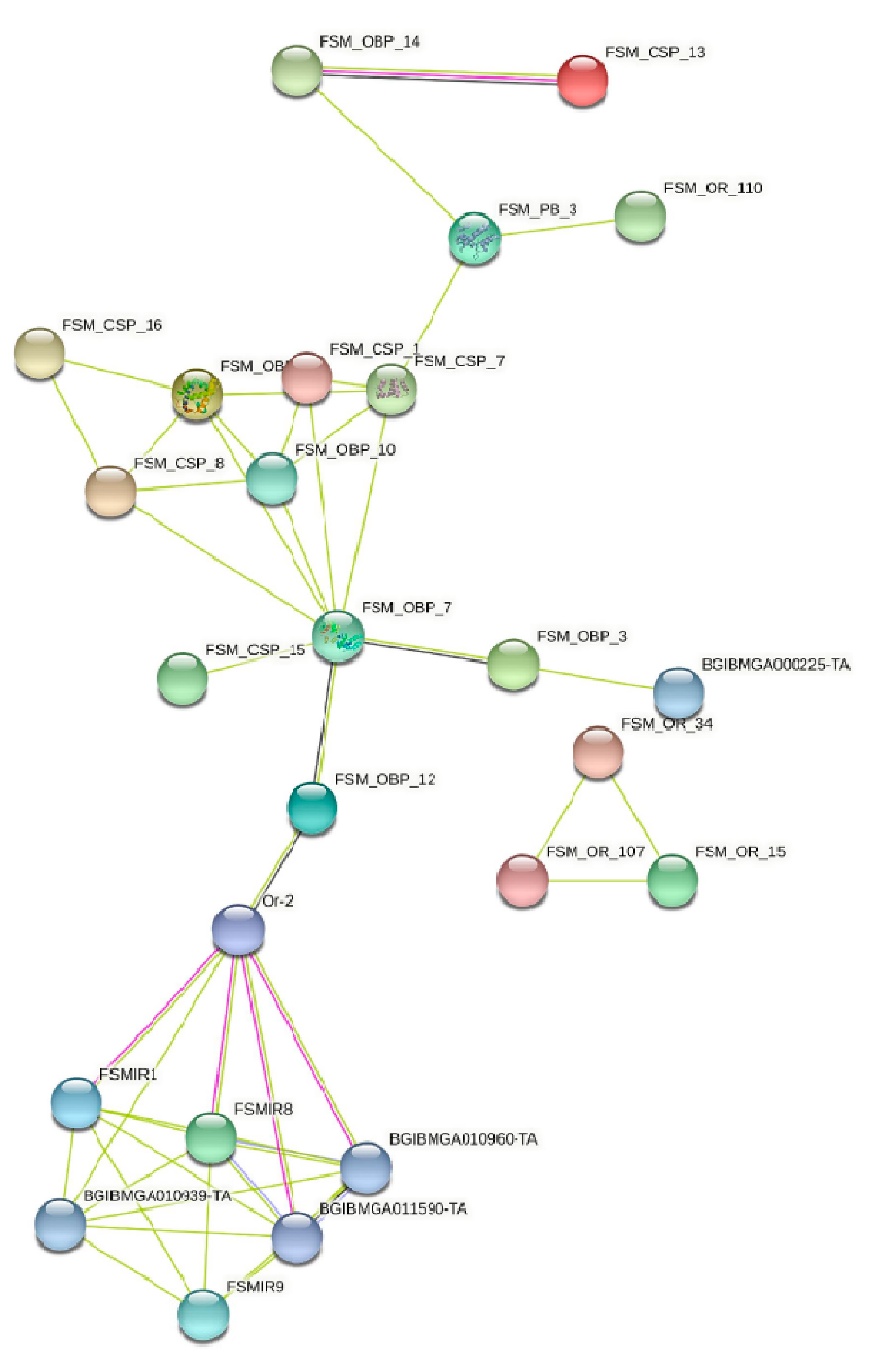
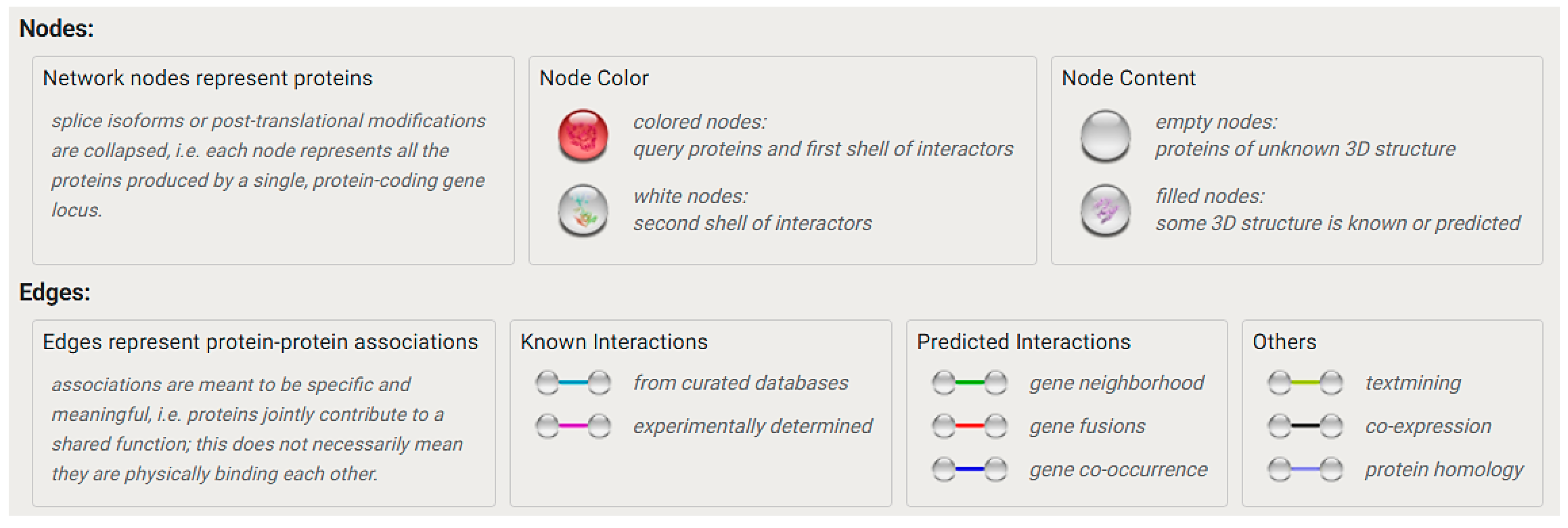
| SNO. | Accession ID | Description | Primer Name | Primer Sequence |
|---|---|---|---|---|
| 1 | MW186442 | F-BAR domain-only protein 2-like | FSM1F | AACCTACGCATCCCGTACAC |
| FSM1R | GCGCAGTACTTCAATGTGGA | |||
| 2 | MW186443 | Predicted esterase B-1-like | FSM2F | AAGCAACACCAAGGCCTCTA |
| FSM2R | GATACCACTTTGCGCCATTT | |||
| 3 | MW186444 | Carboxylic ester hydrolase | FSM3F | CACCTGTTGGTGGTCACAAG |
| FSM3R | CGTGGCTCACGACTGACTTA | |||
| 4 | MW186445 | Esterase B1 | FSM4F | TAGCGTGTTTGATGCCTCTG |
| FSM4R | GAAGCAGTTCCGTTTCTTGC | |||
| 5 | MW186446 | Acetate esterase-6 | FSM5F | GCCCAGTGAAGAGTCAGGAG |
| FSM5R | CTTTAAAAGCGCTGGATTCG | |||
| 6 | MW186447 | Chemosensory ionotropic receptor75q2 | FSM6F | TGCGTGTCAACAAGGAAGTC |
| FSM6R | CTCCGGTCTCCATGTGAAAT | |||
| 7 | MW186448 | Odorant receptor 4-like | FSM8F | CGACGCAGTTCAATTTGCTA |
| FSM8R | AGCGTCACCTATTCCCACAC | |||
| 8 | MW186449 | Odorant-binding protein 4 | FSM11F | ATTGGGACGATTTGAAGCAG |
| FSM11R | GGCATTGATTTTCGTCCAGT | |||
| 9 | MW186450 | Uncharacterized protein | FSM12F | CTAGAGCTACGCCCGTGAAC |
| FSM12R | TCCCTGCTGCGAAAGTTATT | |||
| 10 | MW186451 | Odorant-binding protein | FSM13F | TTTCCTGGGAACAGGTTGTC |
| FSM13R | TGTTTCGGACGTCGTTGTAA | |||
| 11 | MW186452 | Odorant-binding protein 1 | FSM14F | GGCCGTGATCAAATACAGGT |
| FSM14R | CTTCAGCCTCGGATTGTAGC |
Publisher’s Note: MDPI stays neutral with regard to jurisdictional claims in published maps and institutional affiliations. |
© 2022 by the authors. Licensee MDPI, Basel, Switzerland. This article is an open access article distributed under the terms and conditions of the Creative Commons Attribution (CC BY) license (https://creativecommons.org/licenses/by/4.0/).
Share and Cite
Vyas, M.; Pagadala Damodaram, K.J.; Krishnarao, G. Antennal Transcriptome of the Fruit-Sucking Moth Eudocima materna: Identification of Olfactory Genes and Preliminary Evidence for RNA-Editing Events in Odorant Receptors. Genes 2022, 13, 1207. https://doi.org/10.3390/genes13071207
Vyas M, Pagadala Damodaram KJ, Krishnarao G. Antennal Transcriptome of the Fruit-Sucking Moth Eudocima materna: Identification of Olfactory Genes and Preliminary Evidence for RNA-Editing Events in Odorant Receptors. Genes. 2022; 13(7):1207. https://doi.org/10.3390/genes13071207
Chicago/Turabian StyleVyas, Meenal, Kamala Jayanthi Pagadala Damodaram, and Gandham Krishnarao. 2022. "Antennal Transcriptome of the Fruit-Sucking Moth Eudocima materna: Identification of Olfactory Genes and Preliminary Evidence for RNA-Editing Events in Odorant Receptors" Genes 13, no. 7: 1207. https://doi.org/10.3390/genes13071207
APA StyleVyas, M., Pagadala Damodaram, K. J., & Krishnarao, G. (2022). Antennal Transcriptome of the Fruit-Sucking Moth Eudocima materna: Identification of Olfactory Genes and Preliminary Evidence for RNA-Editing Events in Odorant Receptors. Genes, 13(7), 1207. https://doi.org/10.3390/genes13071207






